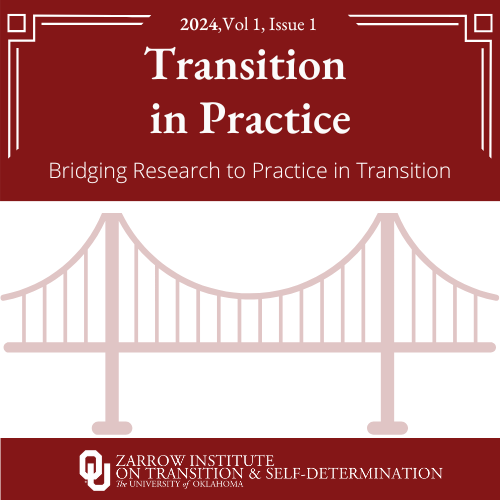Developing Independence in University Housing for Individuals with an Intellectual Disability
Main Article Content
Abstract
The purpose of this mixed method study using a single-case design was to determine if prompt fading is beneficial in increasing the rate of completion in cleaning a dormitory room for three students with an intellectual disability participating in a postsecondary program. In addition, the intervention’s social validity was measured through participant interviews. While the intervention showed a relation with increased clean dormitory rooms for the participants, it was determined the participants preferred the use of technology to conduct the dormitory room checks over in-person measures.
Article Details

This work is licensed under a Creative Commons Attribution-NonCommercial-NoDerivatives 4.0 International License.
This is an open access article distributed under the terms of the Creative Commons License 4.0, CC BY-NC-ND 4.0
References
American Association on Intellectual and Development Disabilities. (2024). Defining criteria for intellectual disability. https://www.aaidd.org/intellectual-disability/definition
Baker, R., Klasik, D., & Reardon, S. F. (2018). Race and stratification in college enrollment over time. AERA Open, 4(1), 1-28. https://doi.org/10.1177%2F2332858417751896
Berg, B., Lee, S., Randolph, B., Ryu, M., & Shapiro, D. (May 2023), Current Term Enrollment Estimates: Spring 2023, Herndon, VA: National Student Clearinghouse
Research Center. https://nscresearchcenter.org/wpcontent/uploads/CTEE_Report_Spring_2023.pdf
Carter, E. W., Austin, D., & Trainor, A. A. (2012). Predictors of postschool employment outcomes for young adults with severe disabilities. Journal of Disability Policy Studies, 23(1), 50-63. https://doi.org/10.1177/1044207311414680
Cheon, J., Lee, S., Crooks, S. M., & Song, J. (2012). An investigation of mobile learning readiness in higher education based on the theory of planned behavior. Computers & Education, 59(3), 1054-1064. https://doi.org/10.1016/j.compedu.2012.04.015
Cooper, J. O., Heron, T. E., & Heward, W. L. (2007). Applied behavior analysis (2nd ed.). Pearson Education.
Creswell, J. W., & Plano Clark, V. L. P. (2018). Designing and conducting mixed methods research (3rd ed.). Sage.
Creswell, J. W., & Poth, C. N. (2017). Qualitative inquiry and research design: Choosing among five approaches (4th ed.). Sage.
Dell’Armo, K. A., & Tassé, M. J. (2019). The role of adaptive behavior and parent expectations in predicting post-school outcomes for young adults with intellectual disability. Journal of Autism and Developmental Disorders, 49(4), 1638-1651. https://doi.org/10.1007/s10803-018-3857-6
Eisenman, L., & Mancini, K. (2010). College perspectives and issues. In M. Grigal, & D. Hart (Eds.), Think college: Postsecondary education options for students with intellectual disabilities, (pp. 161-187). Paul H. Brooks.
Fraga, L. M., & Flores, B. B. (2018). Mobile learning in higher education. In J. Keengwe (Ed.), Handbook of research on mobile technology, constructivism, and meaningful learning (pp. 123-146). IGI Global. https://doi.org/10.4018/978-1-5225-3949-0.ch007
Graff, H. J., Brady, S. B., Mason, L. H., & Myers, B. (2019). Research trends explored over the last two years in inclusive postsecondary education. Journal of Inclusive Postsecondary Education 1(2), 1-9. https://journals.gmu.edu/index.php/jipe/article/view/2477/1545
Grigal, M., Hart, D., & Weir, C. (2013). Postsecondary education for people with intellectual disability: Current issues and critical challenges. Inclusion, 1(1), 50-63. https://doi.org/10.1352/2326-6988-1.1.050
Higher Education Opportunity Act of 2008, P.L. 110–315, 20 U.S.C. §§1001 et seq. (2008). https://www2.ed.gov/policy/highered/leg/hea08/index.html
Kelley, K. R., & Westling, D. L. (2019). Teaching, including, and supporting college students with intellectual disabilities. Routledge. https://doi.org/10.4324/9780429461378
Kirkendall, A., Doueck, H. J., & Saladino, A. (2008). Transitional services for youth with developmental disabilities: Living in college dorms. Research on Social Work Practice, 19(4), 434-445. https://doi.org/10.1177/1049731508318734
Kratochwill, T. R., Hitchcock, J., Horner, R. H., Levin, J. R., Odom, S. L., Rindskopf, D. M., & Shadish, W. R. (2010). Single-case designs technical documentation. What works clearinghouse. https://ies.ed.gov/ncee/wwc/Docs/ReferenceResources/wwc_scd.pdf
Lynch, K. B., & Getzel, E. E. (2013). Assessing the impact of inclusive postsecondary education using the Think College standards. Journal of Postsecondary Education and Disability, 26(4), 416-426. https://files.eric.ed.gov/fulltext/EJ1026892.pdf
Martella, R. C., Nelson, J. R., Morgan, R. L., & Marchand-Martella, N. E. (2013). Understanding and interpreting educational research. Guilford Press.
Newman, L., Wagner, M., Knokey, A. M., Marder, C., Nagle, K., & Wei, X. (2011). The post high school outcomes of youth with disabilities up to 8 years after high school: A report of findings from the national longitudinal transition study-2 (NLTS2). SRI International. https://ies.ed.gov/ncser/pubs/20113005/pdf/20113005.pdf
Papay, C., Grigal, M., Hart, D., Kwan, N., & Smith, F. A. (2018). Predictors of inclusive course enrollments in higher education by students with intellectual and developmental disabilities. Intellectual and Developmental Disabilities, 56(6), 458-470. https://doi.org/10.1352/1934-9556-56.6.458
Rowe, D. A., Alverson, C. Y., Unruh, D. K., Fowler, C. H., Kellems, R., & Test, D. W. (2015). A Delphi study to operationalize evidence-based predictors in secondary transition. Career Development and Transition for Exceptional Individuals, 38(2), 113-126. https://doi.org/10.1177/2165143414526429
Schalock, R. L., Brown, I., Brown, R., Cummins, R. A., Felce, D., Matikka, L., Kenneth, K., & Parmenter, T. (2002). Conceptualization, measurement, and application of quality of life for persons with intellectual disabilities: Report of an international panel of experts. Mental Retardation, 40(6), 457-470. https://doi.org/10.1352/0047-6765(2002)040<0457:CMAAOQ>2.0.CO;2
Stringer, E. T. (2007). Action research (3rd Ed). Sage. http://repository.umpwr.ac.id:8080/bitstream/handle/123456789/3706/Action%20Research.pdf?sequence=1
Thomas, D. R. (2006). A general inductive approach for analyzing qualitative evaluation data. American Journal of Evaluation, 27(2), 237-246. https://doi.org/10.1177%2F1098214005283748
Wagner, E. D., & Wilson, P. (2005). Disconnected: Why learning professionals need to care about mobile learning. T+ D, American Society for Training and Development, 43(12), 40-43.
Yazedjian, A., Toews, M. L., Sevin, T., & Purswell, K. E. (2008). "It's a whole new world": A qualitative exploration of college students' definitions of and strategies for college success. Journal of College Student Development, 49(2), 141-154. http://doi.org/10.1353/csd.2008.0009

